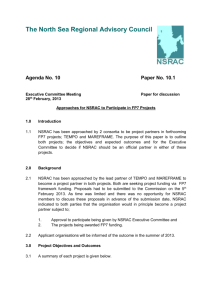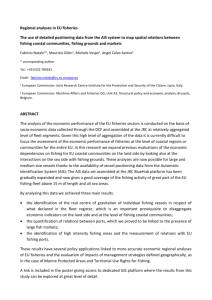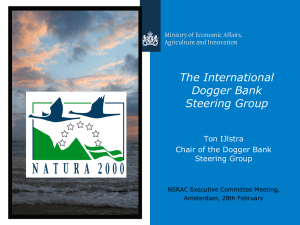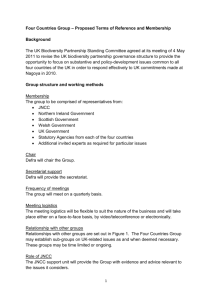NSRAC EX Ostend Spatial Planning WG report
advertisement
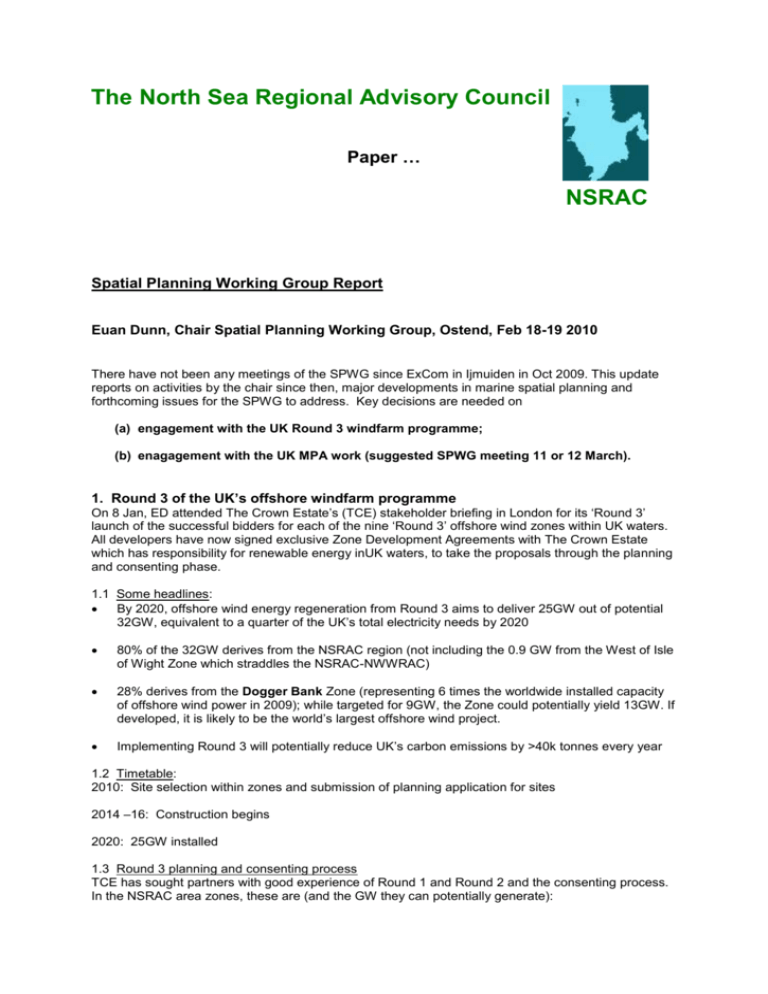
The North Sea Regional Advisory Council Paper … NSRAC Spatial Planning Working Group Report Euan Dunn, Chair Spatial Planning Working Group, Ostend, Feb 18-19 2010 There have not been any meetings of the SPWG since ExCom in Ijmuiden in Oct 2009. This update reports on activities by the chair since then, major developments in marine spatial planning and forthcoming issues for the SPWG to address. Key decisions are needed on (a) engagement with the UK Round 3 windfarm programme; (b) enagagement with the UK MPA work (suggested SPWG meeting 11 or 12 March). 1. Round 3 of the UK’s offshore windfarm programme On 8 Jan, ED attended The Crown Estate’s (TCE) stakeholder briefing in London for its ‘Round 3’ launch of the successful bidders for each of the nine ‘Round 3’ offshore wind zones within UK waters. All developers have now signed exclusive Zone Development Agreements with The Crown Estate which has responsibility for renewable energy inUK waters, to take the proposals through the planning and consenting phase. 1.1 Some headlines: By 2020, offshore wind energy regeneration from Round 3 aims to deliver 25GW out of potential 32GW, equivalent to a quarter of the UK’s total electricity needs by 2020 80% of the 32GW derives from the NSRAC region (not including the 0.9 GW from the West of Isle of Wight Zone which straddles the NSRAC-NWWRAC) 28% derives from the Dogger Bank Zone (representing 6 times the worldwide installed capacity of offshore wind power in 2009); while targeted for 9GW, the Zone could potentially yield 13GW. If developed, it is likely to be the world’s largest offshore wind project. Implementing Round 3 will potentially reduce UK’s carbon emissions by >40k tonnes every year 1.2 Timetable: 2010: Site selection within zones and submission of planning application for sites 2014 –16: Construction begins 2020: 25GW installed 1.3 Round 3 planning and consenting process TCE has sought partners with good experience of Round 1 and Round 2 and the consenting process. In the NSRAC area zones, these are (and the GW they can potentially generate): 2 i) ii) iii) iv) v) vi) vii) Moray Firth: Moray Firth Renewables (1.3GW) Firth of Forth: SeaGreen Wind Energy (3.5GW) Dogger Bank: Forewind Consortium (9GW) Hornsea: Siemens Project Ventures and Mainstream Renewable Power (4GW) Norfolk Bank: East Anglia Offshore Wind Ltd (7.2GW) Hastings: Eon Climate and Renewables (0.6GW) [West of Isle of Wight: Eneco New Energy (0.9GW)] 2 3 Note that while Zones 1-4 are wholly outside 12nm, a small part of 5 extends inside 12nm, most of 6 is inside 12nm and more than half of 7 is inside 12nm. [NB: Zones show clearly on screen but not in monochrome print-out] A Zone is an area in which windfarm sites can be located and it is down to the Zone developer to propose those sites based on their understanding of opportunities and constraints. So developers will engage with stakeholders during the 2010-2014 phase of site investigation and assessment (including EIA). TCE has newly appointed Colin Warwick as National fisheries liaison officer to engage with the fishing sector at ‘the highest strategic level’. TCE says: ‘Colin has over 40 years experience in the fishing industry and has been awarded an MBE for services to the fishing industry. He has great knowledge of how emerging industries should interact with the fishing industry through his experience of oil and gas and telecoms cables. Colin joins us part time for 2 days a week. Initially he will be very busy developing an inclusive engagement strategy for offshore wind and commercial fishing and, in due course, ongoing operational oversight.” Taking the development of any Zone forward requires the developer to undertake a Zone Appraisal & Planning process (ZAP). ZAP will build on desk-based assessments undertaken to date, to further refine the capacity of the Zone and enable the developer to formulate a strategy for the development of the Zone; this is likely to happen in stages (at least for the bigger areas like Dogger), with a number of separate applications submitted over several years to the Infrastructure Planning Commission (IPC) which is the UK consenting body. 1.4 Example: Dogger Bank (developer = Forewind) Forewind are in the process of appointing a consultant to act as ZAP Coordinator. They intend to develop the Zone in four tranches, each of 3GW. The ZAP will identify the location and prioritisation of these tranches. Even within each tranche, the 3GW generating capacity may be taken forward as separate, individual projects. Forewind intends to submit a request(s) for a Scoping Opinion to establish the scope of the first Environmental Impact Assessments (EIAs) to the IPC by Aug 2010 for the 1st tranche of applications it intends to develop. This will inform the way in which the tranches/sites are developed/prioritised. Key Dogger Bank ZAP Development Tasks Review available Zone data Preliminary ZAP strategy including survey scopes Statutory Consultee meetings Review information collected from Consultees and refine ZAP strategy and data gap analysis Wider consultation workshops Approximate timescale Feb 2010 Feb 2020 February 2010 Spring 2010 Spring 2010 I have alerted Forewind to the need to consult with the NSRAC and to suggest that a bespoke meeting with the Spatial Planning WG may be the best option. They are consulting internally about this and will come back to me soon. Issues the NSRAC could address with Forewind include: - Placement of sites within Zones in relation to fishing activity - Fisheries mitigation measures - Management of any disruption/displacement of fisheries - Establishment of safety zones 3 4 Questions for the NSRAC: Should the NSRAC engage with the ZAP process and, if so, how? Is there a need for a presentation from one or more of the Zone developers, and – if so – how (e.g. Spatial Planning WG meeting) and when? Which Zones other than Dogger Bank are (most) relevant? 2. Update on UK consultation on Dogger Bank SAC proposal Given the overlap of the tentative SAC boundary with the Zone 3 windfarm area, there has been no progress since the message received (June 2009) form Defra (UK): While the UK Government is minded to agree that the UK section of the Dogger Bank should be an SAC, this is subject to further discussion and examination of the scientific basis for selection, especially with regard to the boundaries of the site. We hope to make progress with regard to this site during this year, but it is unlikely that the Department will consult on any proposals for the Dogger Bank until after Autumn this year. Clearly, no such proposal was made in 2009. Assuming Defra (on behalf of UK Government) accepts JNCC’s advice to proceed with a proposal for a Dogger Bank SAC, a formal consultation may begin in 2010 with a view to submitting a Dogger Bank SAC proposal, along other SAC proposals, to the European Commission by Defra’s original deadline of September 2010. Useful websites: Seafish MPA page: http://www.seafish.org/b2b/info.asp?p=345 JNCC Guide to MPAs: http://www.jncc.gov.uk/pdf/MPAsInfoDoc_v2_0.pdf Defra MPA page: http://www.DEFRA.gov.uk/environment/marine/protected/mpa/index.htm 3. The UK MCZ Project As the NSRAC heard from the presentation by JNCC in Ijmuiden, new national MPAs are being proposed under the UK Marine and Coastal Access Act (2009) and the Marine (Scotland) Bill. In England and Wales, these sites are called Marine Conservation Zones (MCZs) and - in Scotland – Marine Protected Areas. For Scottish waters, Scottish Ministers will designate MPAs in territorial waters under the Scottish Marine Bill and in offshore waters (including the UK Continental Shelf beyond 200nm) under the UK Marine and Coastal Access Bill. The MCZ Project (England & Wales) has been established by Defra, Natural England, and JNCC to identify and recommend MCZs to the Government in English territorial waters and all UK offshore waters apart from Scotland. The overall MCZ Project will be delivered through 4 Regional (Stakeholder) Projects, of which the North Sea is one. They will work with sea users and interest groups to identify MCZs and provide recommendations for sites within their regions. There are 2 Regional Projects for the English part of the North Sea: Balanced Seas (South-East & E Channel – green on the map) and Net Gain (E England yellow on the map). 4 5 JNCC has produced a guide on the MCZ Project, its process and how stakeholders can get involved: http://www.jncc.gov.uk/PDF/MCZProjectInfoDoc_v1_1.pdf 3.1 JNCC Strategy for the non-UK fishing sector JNCC recognises the need to engage with the fishing sector in Member States other than the UK in respect of potential MCZs in the ‘Balanced Seas’ and Net Gain’ Regional Projects. However, JNCC also recognises that international cooperation is essential to successfully manage the entire suite of MPAs currently being developed as a coherent network across UK waters (i.e. MCZs, Scottish MPAs and Natura 2000 sites). To this end, JNCC is in the process of appointing international liaison officers. The primary purpose of international fisheries liaison is: to establish a dialogue on current and future MPA site developments to facilitate engagement on their establishment to collect data on use of UK seas by non-UK fleets for the evidence base needed for MPAs to be established under: - UK Marine and Coastal Access Act 2009 Marine (Scotland) Act 2010 Habitats and Birds Directives Potential fisheries management measures established under the CFP Engagement with the international fishing sector requires understanding and agreement across the projects regarding what the stakeholders are being asked to do, what data is being requested, how it will be used, and what messages will be conveyed. 5 6 3.2 What data is required? A fair stakeholder engagement process requires that information obtained from the non-UK fishing sector representatives should be consistent with (and of the same quality as) that obtained from the UK’s local and national fishing sector representatives. Ideally, the data collected should include: Where the fleet are fishing How the fleet are fishing (e.g. gear types) The value of an area to a fishery Effort of the fishery in a given area Relative importance of an area to the fishery (i.e. is it the only area for a particular fishery? And are there other countries that fish there?) 3.3 The NSRAC consultation process It is important that the NSRAC is addressed on a comprehensive scale and not separately by either one of the North Sea Regional Stakeholder Projects. On this basis, JNCC is keen to engage with the NSRAC as soon as possible to explain in greater detail the project and address engagement issues of data collection (including confidentiality, data ownership, access etc). Recommendation: A one-day Spatial Planning WG meeting be held in London on Thurs 11 or Fri 12 March. Views on this will be sought at the Ostend ExCom. 4. Workshops on the development of fisheries management measures in Natura 2000 sites in the Dutch EEZ (FIMPAS) There will be 3 workshops in 2010 and 2011 on the development of fisheries management measures in Natura 2000 sites in the Dutch EEZ and to observe the formulation of the final advice on the appropriateness of such measures through the ICES process (final proposal being the responsibility of the ICES Advisory Committee (ACOM). The final result of FIMPAS will be the basis for a Dutch-led proposal to the Commission for the adoption of fisheries measures in the Natura 2000 sites. Other countries with an EEZ on the Dogger Bank will be invited to consider a joint proposal for measures in the area. The first workshop will be held in Scheveningen, Netherlands, on 22-124 Feb. It is hoped that NSRAC will be represented. 6
